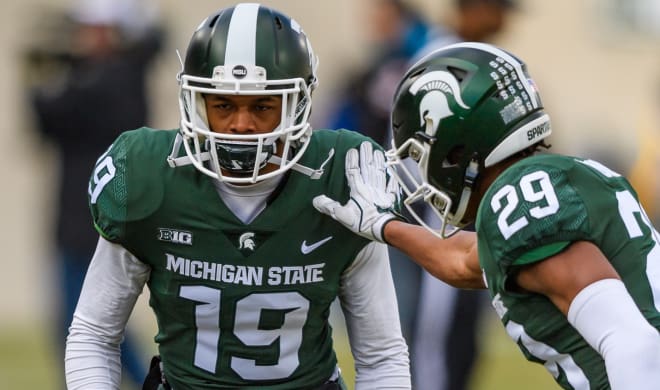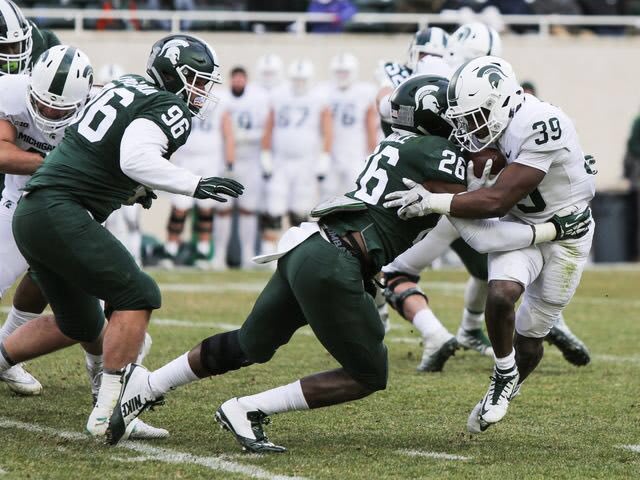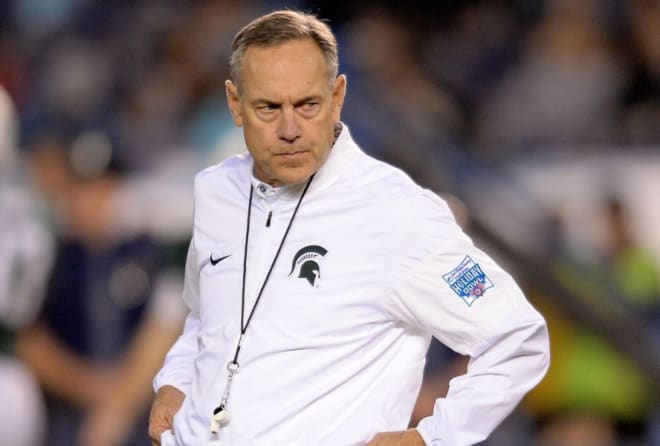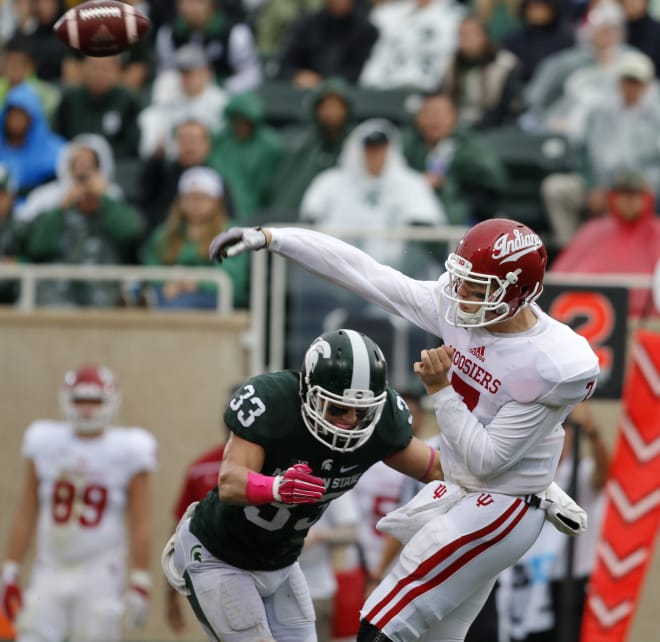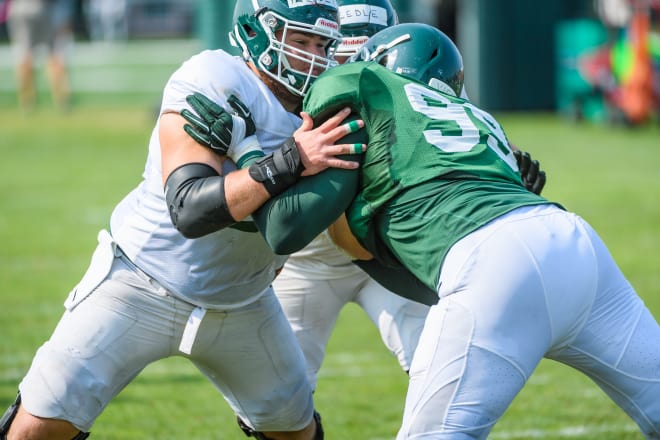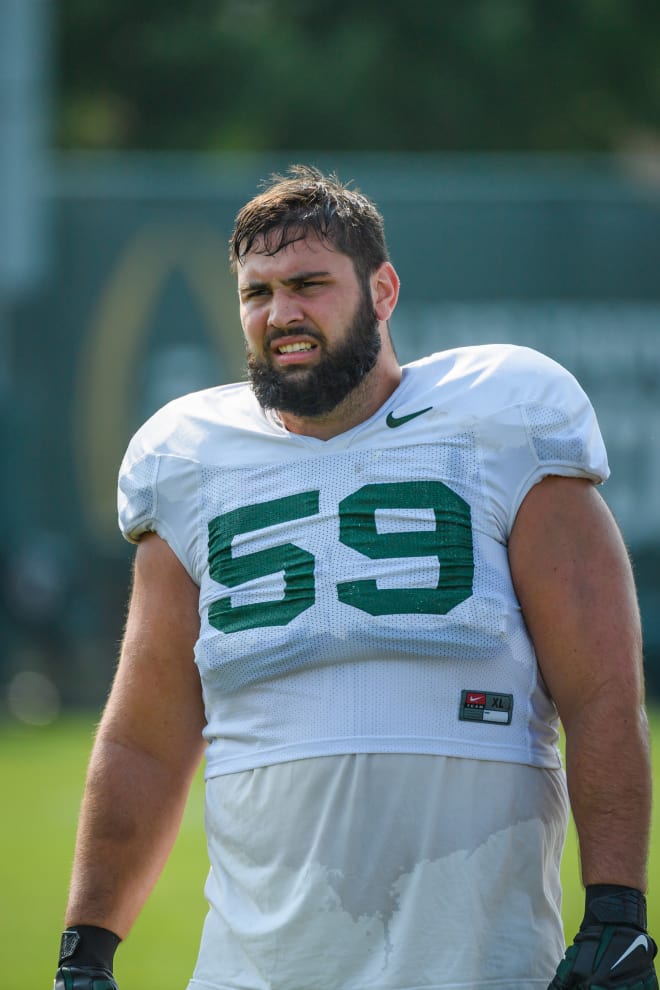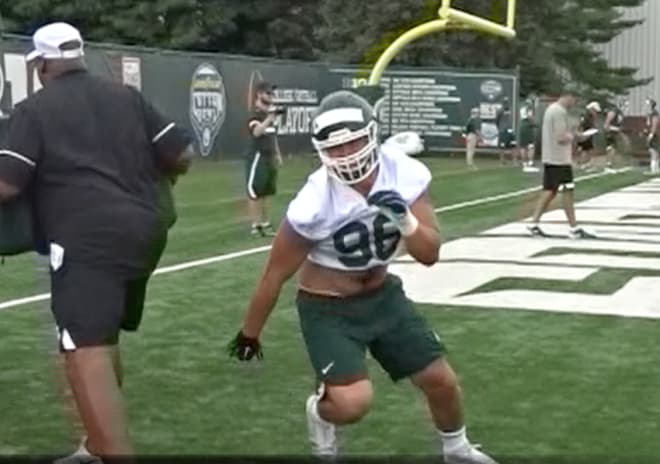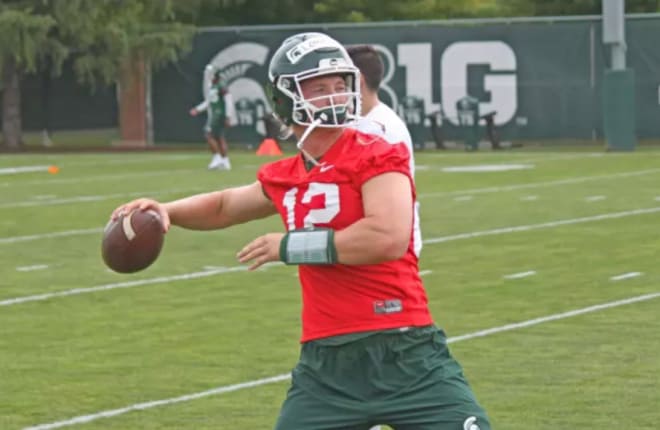Pre-Snap Read: MSU vs Utah State
By Jim Comparoni
This is the one day a year in which I write about where I THINK Michigan State is, as a team, and what challenges I THINK the opponent will present, less than 30 hours from kickoff.
We’ve talked about Michigan State through June and July, the games coming up at Arizona State, at Penn State, the Michigan game, can Michigan State get past Ohio State, can Michigan State compete for the Big Ten East championship?
We’ve bandied the same questions around since June. Or since March. Or since February. And we don’t know much more about the Spartans now than we did in January.
A few things of note have happened since January. Michigan State has apparently gone through spring practice and August camp without any season-ending injuries.
Josiah Scott won’t be available at cornerback. There are concerns about
Cole Chewins. But no news is somewhat good news on the injury front.
Jon Reschke is back.
Tyler Higby is the new center.
Jacub Panasiuk has a chance to give Michigan State a decent bookend opposite
Kenny Willekes.
With Michigan State returning 19 starters, and something like 40 of the top 44, there are fewer questions heading into this season than I can ever remember.
I used to write an annual column in SPARTAN Magazine at this time of year in which I would list the x-factors for the coming season. As a rule of thumb, I discovered that seasons in which there were MORE x-factors, i.e. question marks, were the seasons in which Michigan State was less likely to climb to .500 or better.
Not surprisingly, the seasons with the fewest x-factors turned out the best.
If I were to write that column today, about the x-factors for the 2018 season, there wouldn’t be many (as long as the team doesn’t get hit hard by the injury bug).
The question marks? Higby at center? Not much of a question. He’ll be solid.
Matt Sokol at tight end? He’s a former starter. I think he’s ready to go from functional to a plus player.
Replacing Josiah Scott? That’s a task. Michigan State will be at least functional with
Josh Butler. His back-up,
Tre Person, has a good reputation on the practice field. But he’s unproven. I think he’s going to be good some day. He’s exciting. But he hasn’t done it yet. So he’s an x-factor. But he’s not a starter.
You have to dig into the second string to find question marks and x-factors.
Back-up QB? If that’s one of your team’s biggest question marks, then your team probably doesn’t have many problems.
True freshman
Xavier Henderson at the slot corner position in the nickel defense? He’s talented and poised beyond his years, but he’s still a teen-aged rookie. Teen-aged rookies almost never play smooth, relaxed and up to their potential in their first few games. I remember
Renaldo Hill getting grief from fans after getting beat a few times.
Henderson will be good. But there will be a process. Michigan State is willing to wade through that process to get him ready for the rest of it.Butler played the slot nickel position last year. From all indications, it sounded like Henderson was the choice ahead of Butler at nickel slot corner coming out of the spring. Butler is functional. So I would have to assume Henderson is functional-plus.
(So why didn’t Henderson compete for the corner job when Scott went down with the injury? Well, Henderson is more of a true safety. It would have been harder for him to make the move from safety to corner than it was for Tre Person).
* The replacement for
Chris Frey? Frey was good, a motor guy, a full-tilt guy, kind of inspirational. But he missed his share of tackles and pass defense assignments. Michigan State continues to stage auditions between
Tyriq Thompson, Brandon Randle and even Reschke for work at ‘money’ linebacker.
Frey was an overall plus. There is no guarantee that his replacements will out-produce him, but I wouldn’t bet against it. I suppose that’s an x-factor with upside.
Five, 10, 12, 15 years ago, I remember the x-factor column listing five, six, eight areas of key unknowns. That’s not the way Michigan State is anymore.
The Top 40 players in the program are solid, they’re proven, they’re committed. You know what you’re going to get from them, which makes football life happier for the fans, doesn’t it?
So Michigan State is primed, charged, talented and ready to kick this thing off. The offense didn’t produce fireworks last year, but on a points-per-possession basis, the Spartan offense could become quite effective and efficient this year. After practice on Tuesday, Brian Lewerke said he was looking forward to seeing how many points this offense can score. He’s not the type of guy who gets cranky about public perceptions, but he seems eager to help prove that MSU’s offense isn’t a plodding Pinto.
Don’t assume that MSU’s nationally-ranked defense, with nine returning starters, is automatically going be better than MSU’s offense. I think that’s going to be a tight comparison in 2018, which should be good news for Spartan fans.
**
This is also the day of the year when I try to gauge how dangerous the opponent is. The opening-night opponent is usually a mid-major, sometimes an FCS team, usually coming off a winning season, usually with optimism of their own. And we never have any film of them. So the gauges and guesses are even more prone to err than usual.
Here’s the point: We’ve never seen these two teams play. Michigan State? We think we know what they are, but we haven’t seen them play. Same thing, to a much higher degree, with Utah State.
What’s the level of concern for this game?
I would say Michigan State, and its fans, should have more concern for this game than was the case for last year’s opener against Bowling Green, or the 2016 opener vs. Furman, or the 2014 opener against Jacksonville State or the 2011 opener vs Youngstown State.
The concern level should maybe be similar to the game at Western Michigan in 2015 (which Michigan State won 37-24, but allowed a mess of yards).
That WMU team turned out to be better than anyone expected in 2015, and much better a year later. That WMU team had legitimate NFL talent at more positions than I think this Utah State team will have, but in terms of the level of concern heading into a season opener, I would equate it to 2015. One difference is that Michigan State will be playing this game at home. Playing at WMU in 2015 was probably worth 10 to 12 points for the Broncos.
**
Here are my macro takeaways on Utah State after watching a couple of their games from last year, and researching their personnel:
1. I’ve never seen an Michigan State opponent with so many transfers.
Twelve of Utah State’s starting 22 did not begin their college football careers at Utah State. Eight of their starters are junior college transfers. Six of them transferred from Oklahoma State, TCU, USC, BYU, Texas Tech, Tennessee-Chattanooga. Four of those guys transferred from those BCS schools, to a juco, then to Utah State.
There are two BYU transfers in the starting lineup.
2. You’ve probably heard that Utah State returns all five of its o-line starters. That’s pretty much true, although the left tackle was a spot starter last year. You may not have heard that two of the seniors on the o-line are at least 24-years-old after redshirting at BYU, going on an LDS mission, and then transferring through junior college to Utah State. There are some grown men on this team. The last time Michigan State faced a team with grown men, BYU manhandled the Spartans during a terrible 2016 season.
3. There is a chance Utah State will start first-year juco transfer
Darwin Thompson (5-8, 200) at running back.
The last time Michigan State faced a team with a first-year juco transfer at RB, the guy’s name was
Rueben Droughns, of Oregon, and he promptly out-played Sedrick Irvin during a beatdown of Nick Saban’s Spartans in 1998.
That Oregon team was loaded. I’m not going to compare that Oregon team, of Akili Smith, with this Utah State team by any means. But none of us had any idea who or what Rueben Droughns was going to be.
During the talking season, the unknown is undefeated. But on gameday, an unknown first-time starter is usually not something to be overly concerned with. But I have no idea what that guy plays like.
FINAL ANALYSIS FIRST:
* You’ve been hearing all year about Utah State being an uptempo spread team.
Please realize that just because a team is a spread/tempo team doesn’t mean they are a pass-happy offense.
Utah State attempted more run plays than pass plays last year. The Aggies are close to 50-50 in terms of play call balance.
* Utah State’s run game is pretty basic by spread/tempo standards. They use the zone, the zone read, some split zone, some zone RPOs. It’s conventional spread offense, with the bubble screen threat to the slot WR seemingly an option at all times.
They throw the RB quite a bit, like Washington State did. They’ll swing it out to him in the flat, in rhythm, if the read takes the QB there.
As is in the case against most spread teams, pursuing and tackling in space will be key for Michigan State. Michigan State is ready to do that, and do it while keeping starters fresh, and using second- and third-stringers.
* Utah State’s o-line is experienced, but they’re not great. There have been times when I’ve said the o-line of a Central Michigan or a Western Michigan was of Big Ten caliber. This Utah State o-line is probably similar to those, maybe a notch lower, in my opinion.
Michigan State’s run defense ranked No. 2 in the country last year. I don’t think MSU’s run defense was ACTUALLY as good as that statistical ranking, but the run defense was good. This year it will be better.
I would be floored if Utah State is able to run the ball with any consistency. I would be disappointed in Michigan State if the Spartans allow more than 75 yards rushing.
Utah State’s run offense is decent. The QB is a threat on the zone read keeper, maybe six or seven times a game. Last year’s top tailback graduated. He was a MAC-level type of RB. The second-stringer (Gerald Bright, 5-9, 195, Jr., 249 yards last year, 8.9 per carry) is back. If he played for Michigan State last year, I doubt he would have been ahead of Madre London in the three-deep.
They run the zone, and the zone, and the zone. They’ll occasionally pull the left guard and run ‘power’ read option.
Penn State last year, with the best RB in America, wasn’t varied enough with its run game. That’s why Barkley barely rushed for more than 1,200 yards and was bottled up by several teams.
Utah State last year was similarly homogenous with its run plays. The double-teams as part of their zone concepts last year will be handled by MSU’s defensive front. The pull guards get to their landmark, but not with freight-train ferocity.
MSU’s defense has a big reputation, especially the front seven. They should be revved up and ready to go. Forget the 75-yard mark, I would be disappointed in Michigan State if the Spartans didn’t go 1975 Steelers vs the run game on Friday night. That’s a lot to ask, because Utah State was a bowl team last year, a respectable .500 in the respectable Mountain West, and Utah State has a respectable ground game as part of a respectable offense. But Michigan State is expected to be disrespectful on defense, especially vs. the run. So set the expectations high on defense, and look for the Spartans to live up to them.
There is one caveat: This is opening night. There is a chance Utah State might have revamped the way it tries to run the ball, and might hit Michigan State with some wrinkled. That could be worth a drive or two. Youngstown State hit Michigan State with some strange ball control cross buck type of stuff during the 2011 opener. Wrinkles are always a possibility. Heck, Penn State changed its offense midway through the 2016 season and won a Big Ten title doing it.
With Utah State, I doubt we’ll see many changes. They’ll run their inside zone, they’ll work the QB read, and the RPO. I expect them to remain who they are. Offensive coordinator
David Yost is a colorful cat who looks more like a stunt double for Jeff Daniels’ bushy-blonde character in
“Dumb and Dumber” than a football coach.
I try not to judge anyone by their looks. But I like this guy's style.
He’s certainly wise and well-credentialed when it comes to this sport.
His background:
* 2017: OC at Utah State
* 2016: pass game coordinator and QBs coach for Mark Helfrich at Oregon.
* 2013-15: Inside WRs coach for Mike Leach at Washington State.
* 2009-2012: OC for Gary Pinkel at Missouri.
He was credited with developing a great run of QBs at Missouri (
Brad Smith, Chase Daniel, Blaine Gabbert) when zone read spread was in its infancy.
So this guy feels confident in his chalk. I could be wrong, but I wouldn’t expect any major changes to their offense this year. They’re going to try to hit the inside zone, and I expect Michigan State to stuff it.
Utah State head coach
Matt Wells says he expects MSU’s defensive front seven to be the best they see all year.
You might think “duh,” but don’t disrespect Utah State or the Mountain West like that. They played plenty of reputable teams last year, including Wisconsin (losing 59-10, after leading 10-0 for most of the first half), Wake Forest, BYU, Colorado State, Boise State.
Wake Forest is a quality team, in case you didn’t know. Dave Clausen is one of the best coaches in the country you’ve never heard of.
They won’t get freaked out by MSU’s stadium or talent. But they’re going to need to find a way to win outside of the run game.
**
* Utah State’s pass game is predicated off of zone read play action. The QB,
Jordan Love (6-4, 225, Soph., Bakersfield, Calif.)
* Started the final six games at QB as a freshman in 2017, taking the job from an incumbent senior who had passed for more than 7,000 career yards. They think Love is the future, and they began investing reps and playing time in him last year, hoping for a Boise State payoff in the years ahead.
He passed for 1631 yards, 8 TDs, 6 INTs, last year, 55 pct. He was 3-3 as a starter.
He might be 4-2 as a starter, with a bowl win, if their all-conference kicker hadn’t missed four field goals in an overtime loss to New Mexico State in the Arizona Bowl.
His coach describes Love as a “cool customer under pressure, versatile, works hard in the film room.”
(As for the incumbent senior from last year, that guy helped Utah State upset Boise State in 2015, but went 5-18 in the next 23 games. So they pulled the plug on him midway through last year. He’s graduated.)
* Love has a dash of athleticism, and a knack to keep it and get upfield. But he’s not going to destroy you with the run like a
Braxton Miller or
Taylor Martinez.
* From what I saw last year, he’s good with slants, and short passes. He can throw on his run to the right, something they probably didn’t do enough of, in the games I watched. His accuracy and timing was spotty last year. But he was a freshman.
Is he the type of guy who will remain spotty with his timing and accuracy? That’s hard to predict.
When Michigan State beat TCU in the Buffalo Wild Wings Bowl in 2012, they held an athletic but erratic former running back named
Trevone Boykin go 13-of-29 passing. He uncorked a couple of long ones, but looked far from NFL potential on that night. Boykin finished fourth in the Heisman Trophy voting in 2014 and played two years in the NFL.
I’m not ready to say that Love isn’t capable of doing what Boykin did. But I’m not ready to say he has no chance to make major improvements.
Login to view embedded media
Senior WR
Ron’Quavion Tarver, a 6-foot-3 juco transfer from Belle Glade, Fla., will big-body you in the red zone. He’s reliable, maybe not a speed burner from what I’ve seen, but he’ll test you.
The WR on the rise might be
Savon Scarver (5-11, 185, Soph., Las Vegas). He had 11 catches last year, but one of them was this one:
Login to view embedded media
Scarver also had a kickoff return for a TD in their bowl game. He’s the most worrisome deep threat, in my opinion.
The combination of the athletic and occasionally-impressive young QB, and a busy but controllable zone read run game, Utah State reminds me on offense of what we’ve seen from Maryland in recent years. Their talent at WR isn’t far from what we’ve seen at Maryland, either.
Their tight end,
Dax Raymond (6-5, 250, Jr.) is a guy Michigan State would love to have RIGHT NOW. He had 41 catches last year and was HM All-Mountain West.
**
I’m not trying to make their offense sound good or great. But if Michigan State shuts them down, take it from me that they will have shut down a Maryland-level offense. That might not sound like a great accomplishment, but this is an opponent worthy of Big Ten respect on offense.
**
Before we get to their defense, let’s talk about their head coach Matt Wells.
He was offensive coordinator for former Utah State head coach Gary Anderson. Wells became head coach when Andersen left Utah State to become head coach at Wisconsin. Anderson was successful at UW, but suddenly left to take the head coaching job at Oregon State, where he surprisingly failed and was fired last year.
Wells has been head coach for five years at Utah State, with four bowl appearances (2-2).
USU’s bowl games under Wells:
W vs Northern Illinois in the Poinsettia Bowl in 2013
W vs UTEP in the New Mexico Bowl in 2014
L vs Akron in the Famous Idaho Potato Bowl in 2015
L vs New Mexico State in the Arizona Bowl in 2016
Those are obviously “mid-major” bowl games, but Utah State has been a respectable participant in the post season for a program with a 22,000-seat stadium.
By the way, Andersen took USU to two bowl games, beating Toledo in the Idaho Potato Bowl in 2012, and losing to Ohio University in the 2011 Famous Idaho Potato Bowl. Prior to that, USU’s most recent bowl appearance was in 1997 when the Aggies played in the Humanitarian Bowl under head coach … John L. Smith.
Smith used to say, “There’s nothing like beating Boise in Boise!”
But Smith’s Aggies team lost to Cincinnati in the Humanitarian Bowl in ’97.
As for Wells, he seems a lot like Gary Anderson: Young, tough, organized.
**
As for Utah State’s brand of tempo on offense, Wells raised some eyebrows this week when he said the Aggies would try to wear down MSU’s defense with tempo.
This was the full-context quote:
"They (Michigan State) are big, strong and physical. Hopefully, the pace can wear them out a little bit and get them tired. There's no secret that we're going to play with pace on offense. To see where they ranked coming out of last year against the teams they did it against is pretty impressive. They're deep and they're talented. It'll be maybe the best we see all year."
So it’s not like he predicted they would wear Michigan State down with tempo. It sounds to me like he feels that their best chance for success.
Michigan State happens to have a strong front seven to contain the run and make Utah State one-dimensional. Michigan State also has good depth at most positions on defense, with defensive end being the only question mark in that category. Michigan State has become well-versed in changing personnel to keep up vs tempo-based offenses. I don’t think the wear-down attempt will succeed.
“I think we’ll be all right in that area,” Kenny Willekes told me on Tuesday.
As for any concerns that Utah State’s spread offense might give fits to Michigan State the way Northwestern’s does, well … as of now Utah State doesn’t have the pass game accuracy and efficiency to hit you with “all the throws” the way Northwestern can. Maybe Love will develop that, but as of last year’s examples, until further notice, they aren’t quite the outfit that Clayton Thorson runs for the Wildcats.
**
ON DEFENSE
Utah State has a new defensive coordinator, so it’s hard to read much into what we saw last year.
Their co-coordinator from last year,
Kendrick Shaver, left in order to take the linebackers coaching job at Washington State.
Last year’s other co-coordinator, is still called the co-coordinator but was basically demoted to linebackers coach at Utah State.
The new defensive sheriff is
Keith Patterson. He was
Todd Graham’s long-time defensive coordinator at Arizona State, Pittsburgh and Tulsa. However, Graham demoted Patterson last year to linebackers coach as Graham unsuccessfully tried to save his job.
None of these guys - Patterson, or last year’s d-coordinator Shaver - have had much statistical success as defensive coordinators, anywhere.
Last year’s Utah State team had a miserable time trying to stop the run, ranking No. 116 in America, allowing 216 yards per game.
They have set out to solve that problem. And it’s an urgent problem. The players say Patterson has new concepts and levels of intensity in terms of improving Utah State’s run fits. I have no idea how much progress they’ve made.
Last year, they often played a 30 front (three down linemen) but showed a four-man front at times against Wisconsin.
They don’t have a lot of brawn. But they would LIKE to keep two safeties deep through most of the early and mid stage of the game, from what I’ve seen. They went to more blitzing and man to man in the fourth quarter of their bowl game against New Mexico State’s spread offense.
Against Wisconsin last year, they tried to make up for their lack of brawn by swarming extra men to the box. There’s nothing revolutionary about that. Washington State played that way all last year, with great success, until they played Michigan State, a game in which the Cougars had little success on defense.
Last year against Washington State's smaller, quick, get-numbers-to-the-ball defense, Michigan State went with its usual style of offense for a possession or two. Then MSU started hammering away with extra tight ends and jumbo personnel. They put a hole in Washington State doing it that way and I would expect Michigan State to try its hand with the ground-and-pound in this game. Maybe not right away. But when Utah State gets into their third, fourth, fifth defensive possession, and they don’t quite have the second string that Michigan State has, I would expect that to be the time when Michigan State tries to load up the run and play bully ball. That approach worked well in MSU’s most recent game and the Spartans would like to test it and see if they can build off of their bowl game performance, getting back to some power football.
**
Utah State’s main attribute on defense last year was their ability to cause turnovers. Utah State forced 29 turnovers last year, the sixth most in the country. And they also picked up five defensive touchdowns off those turnovers, the fourth most nationally.
“We did a tremendous job last year doing that,” Well said. “Ball searching. That's the goal again this year. Hopefully, we'll get a little lucky and get some balls on the ground.”
They seem to prod and hammer at the football more than most teams. That might be why we saw Michigan State seem to drill ball security in new and different ways in August camp than I’ve seen in the past.
**
ADD IT ALL UP
Again, it’s dangerous to try to read tea leaves at this time of year. We haven’t seen these two teams play. We haven’t seen demonstrable strengths and weaknesses; we can only guess.
That being said, I’m expecting Utah State to have a good offensive script of play-action, keep-away passing in the early stages, like they did against Wisconsin last year.
Wisconsin helped by fumbling a snap deep in their own territory on their second possession.
Utah State quickly built a 10-0 lead at the end of the first quarter. Wisconsin dominated from there, but this year’s Utah State team is supposed to be better than last year’s. One Utah State insider told me that this year’s team will be Wells’ most talented Utah State team since his first year on the job when he inherited a good roster from Andersen.
If Utah State from this year played Maryland from last year, I’d call it a toss-up.
Last year, Michigan State beat Maryland 17-7.
I wouldn’t be shocked if Utah State kept this game interesting for three quarters. From there, Michigan State had better not fall prey to Utah State’s propensity to force turnovers.
Overall, down-in and down-out, you have to like Brian Lewerke’s game management, consistency and occasional explosiveness. And you have to like his developing mind for the game, and ability to read defenses with three terrific wide receivers to choose from and MSU's underrated use of route combinations.
Michigan State should have strong balance on offense, and the ability to stuff the run on defense and make Utah State one-dimensional. Those should be healthy building points toward a comfortable, double-digit victory.
